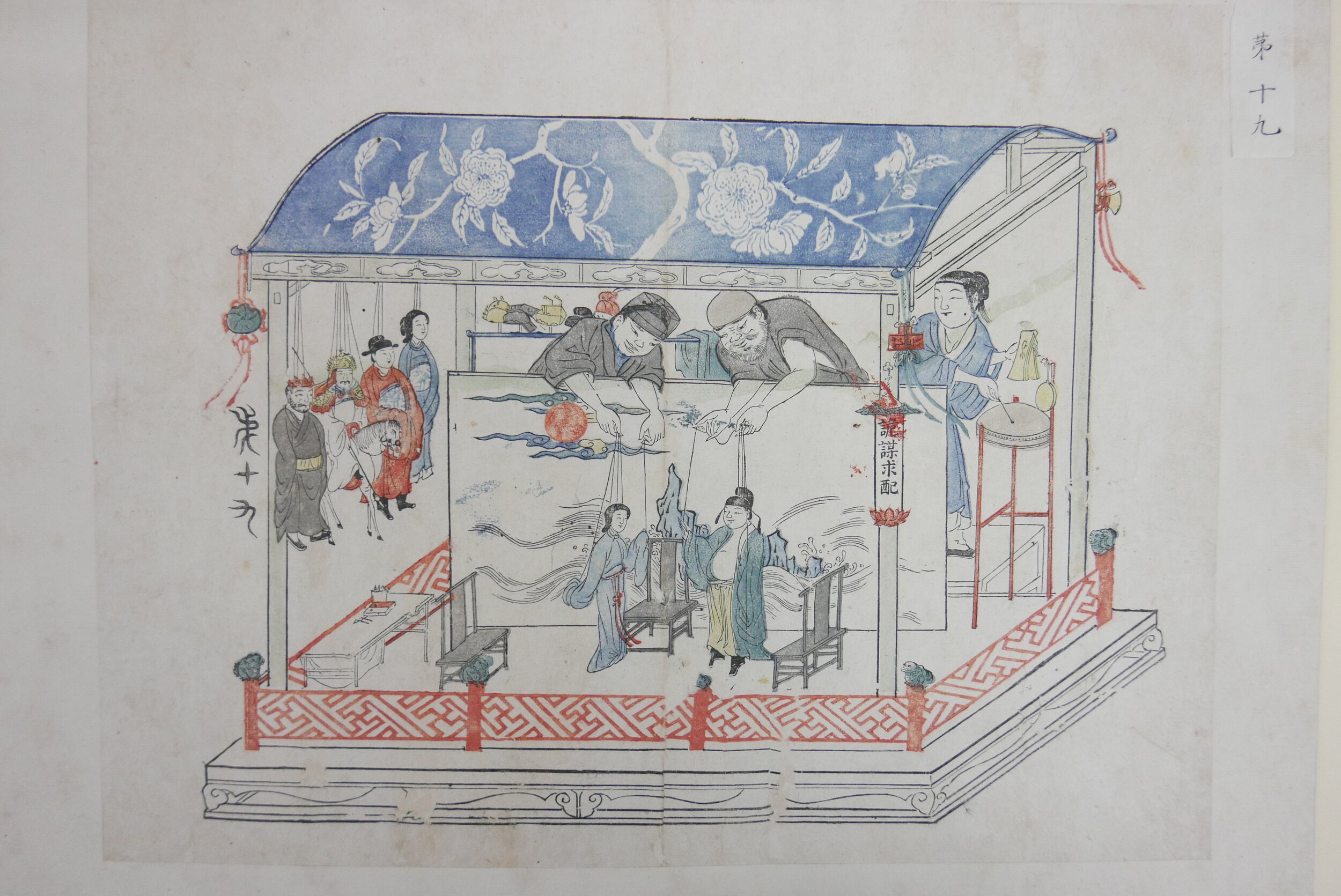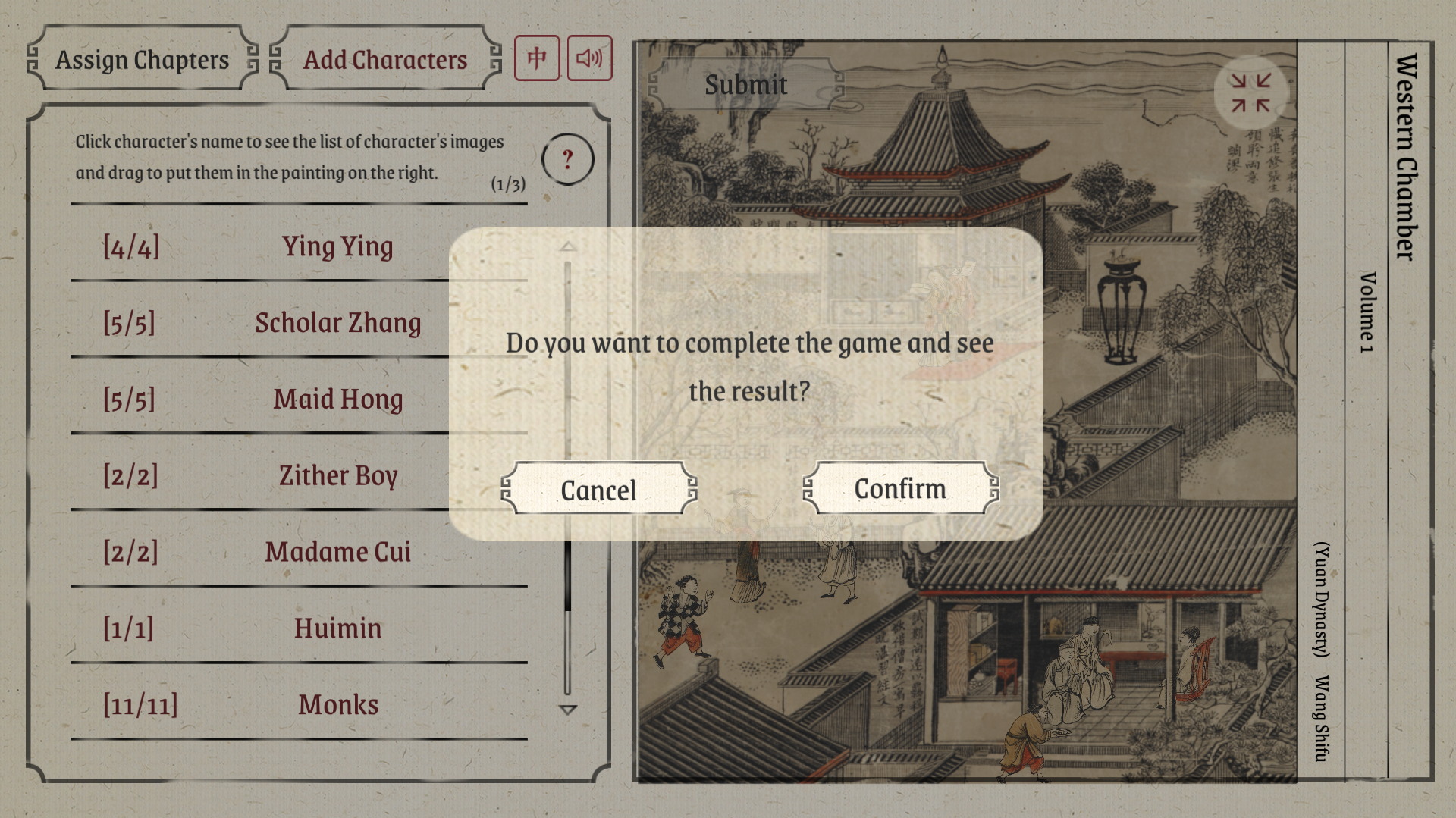
Western Chamber (Educational Game)
Type: Research Project in CAMLab, Harvard University
Time: Aug 2020 - Sep 2021
Role: Game designer, Programmer
Area of Research: Chinese literature and culture communication
Research Goal
“Western Chamber embodies the pattern of manipulating and being manipulated our life and destiny…”
— Eugene Wang, Founder and Director of CAMLab
Min Qiji, illustration of the book "Romance of the Western Chamber"
"Western Chamber (Romance of Western Chamber)" is a famous ancient Chinese literature about a love story that experienced setbacks and embodies ancient China's traditional culture and thought. It also puts forward an eternal philosophical proposition: how to measure and fight against one's destiny.
The research project focuses on revealing the philosophical thought in Western Chamber, combining the story and its derivative artworks in game designing to disseminate Chinese literature's and stimulate players' imagination of Chinese culture to arouse their interests in Chinese culture and philosophy. The final results including two games, the 2D educational puzzle game (this one) and the 3D advanture game, The Dream of Western Chamber.
Personal Contribution
The group's goal is to make an educational game about Western Chamber with relatively simple logic, which spreads the Western Chamber and its related arts and trains students' spatial imagination ability by planning the linear story into space. On the other hand, the game allows students to express their interpretation of the Western Chamber. The game data will be collected and used to analyze the cultural and thinking differences among different countries.
I am the design and programming lead of the educational game, responsible for UX design, level design and implementation using Unity.
Gameplay
Interface Design:
The interface has two interaction areas: left as information management, right as painting completion.
The left part has two layouts for chapters and character management. The language switch and music control button are on the top right of the left part.
The right part is the derivative painting of the Western Chamber, with all characters removed. The number buttons represent important areas that the plots of chapters have happened.
Assign Chapters:
The instructions will show up by clicking the question mark button.
Players can enter the number in the boxes to assign the chapters to areas of the painting.
The repeated input or number that out of the range will be warned with the “!“ on the left.
After assigned correctly, the chapter name will also appear in the painting when the mouse is on the number button.
Players can zoom in the painting by clicking the number button.
Add Characters:
The instructions will show up by clicking the question mark button.
Players can click the character’s name to view the character images that should on the painting.
They can drag and drop the character image to the artwork on the right side and delete the image by pressing the “x“ button on the image's top right.
The image will disappear on the list after drag and drop, and the number will update on the left of the character’s name so that players can see how many characters they already put quickly.
Players can see the translation of the Chinese texts on the painting by placing the mouse on them.
The painting can be dragged to different areas, and the button on the top right can zoom out the painting.
Complete the Game:
The “Submit“ button will show up when players complete the painting by putting all characters’ images in and assigning chapters numbers without repetition.
A confirmation window will jump out after clicking the “Submit“ button.
Result Comparation:
After confirming the submission, the painting with characters will show up, while the players’ version will be darkened and semi transparent for comparison. A reference answer for chapters will also show up.
The game is completed. Players can compare their answers and restart by clicking the button at any time.
Games as Communication Tools for Western Chamber
Chinese culture is full of imagination.
It is difficult for people to fully understand a place's culture with a few lines of words, pictures, or a recorded video. China has thousands of years of history, while the culture change with dynasties, making it harder to trace its development. On the other hand, Chinese culture is full of charm and imagination because of these changes and developments. From oracle bone script to regular script, from pictures to hieroglyphs to straight lines, Chinese character development can represent its culture's imagination and creativity, which comes from figurative to abstract. This way of thinking has greatly influenced the creation of literature and art styles.
Western literature tends to be heroic, while Eastern literature tends to be nihilistic—they pretend to describe the life to be tragic and false.
Min Qiji, illustration of the book "Romance of the Western Chamber"
Most western literature advocates heroes and prefers to describe the protagonist as going through various conflicts and finally achieving success or failure. In this kind of story, the audience is more willing to pretend that they are the protagonist, bring their wishes to the main character. On the contrary, in eastern literature, like Chinese literature, they like to compare life with heaven, earth, mountains, or rivers, with nearly eternal things, to describe life as transient and insignificant. In these stories, the protagonists' actions are not so necessary in the long run; the mountains are still there; the world is still going around. So the audience usually has a hard time, including themselves in the story because it's easy to get disappointed. Since it's essential to put ourselves in its place for understanding a culture, we're looking for an interaction that enhances the sense of substitution, which is the game.
Characters in the Western Chamber fight against the fate, eager to control the so-called fate, but in fact they are all controlled by others.
Chen Hongshou, illustration of the book "Romance of the Western Chamber"
Western Chamber is originated from "Ying Ying's Biography" by Yuan Zhen, Tang Dynasty. Due to the controversy and condemnation of the male protagonist, Wang Shifu adapted the plot in the Yuan Dynasty, which widely spread among China. It tells the story of a man(Scholar Zhang) and a woman(Ying Ying) who fell in love but could not get together because her mother controlled Ying Ying's marriage. In the end, they argued against her mother, who later compromised that if Scholar Zhang can become an outstanding scholar, he could marry the Ying Ying. This struggle against Chinese parents controlling their children's marriages resonated with many people and influenced many later works. The show is a cross between heroism and nihilism. Scholar Zhang and Ying Ying seem trying to fight against their fate, but there are people behind it all the time. The maid thinks they are a good match and tries her best to set them up; Mother does not like Zhang but uses his likes to Ying Ying to solve the bully. They think it's their life, but they may be dolls in someone else's hand. The West Chamber book itself reflects this point too. Its earliest author wrote it as paralysis of his remorse because he abandoned his girlfriend in the past; On the other hand, people were dissatisfied with the hero leaving the heroine. They modified the plot in succession and added new characters to become an obstacle or help between the hero and the heroine, contributing to their final marriage.
Games incorporate all known forms of artistic expression. It’s a higher-dimensional form of expression.
Opera of “Romance of the Western Chamber”
Drama is the expression mode of The Romance of the Western Chamber itself, whose method is similar to the movie, that the audience tends to accept the plot passively. However, as mentioned before, the way of description in Chinese literature makes it difficult for the audience to bring themselves into the characters. Many people can only see the plot without feeling the philosophical logic of fate behind the story. So to positively reflect the thoughts and feelings behind the story, we aim for immersion. The game's interactivity can lead the audience to focus their eyes on the protagonist, put themselves in the position of thinking about how to make things develop in the direction they desire, and transfer the protagonist's fate to the audience. It is the best media to show the Western Chamber because when invisible forces control our destiny, our own experience is entirely different from a spectator. The immersion is one of the most significant features of games, and it's harder for other media to achieve.









